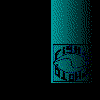












This
period the item is: sardine cichlids. The utmost beautiful specimen of this tribe
that in the meantime extended until
7 members, remains the form "Blue Neon" out of the environment of Chituta
bay
Cyprichromis nigripinnis (BOULENGER,
1901)

A
very slender mouthbreeder
Cyprichromis nigripinnis, formerly known as
Lymnochromis nigripinnis, in nature lives integrated in large groups of
Cyprichromis Ieptosoma. Therefore it is not to be recommenced to keep them
as a pair or even in a little group. Acting like that one would do violence to
the natural way of life. After my opinion even a group of 10 animals still is
not large enough. In larger groups the male will threaten each other regularly;
serious injuries will occur absolutely not. Surely not if from setting up the
tank one makes allowance with the fact that those fishes will never search for
a hiding place in a hole. Subordinate animals and females which are not willing
to mate, will hardly be able to hide. Therefore the number of animals must be
studiously attuned to the room and the possibilities of the aquarium. It also
pays to pay attention to a good proportion of the both sexes. It is not difficult
to distinguish the males from the females. Males have black anal and a caudal
fins, as these fins of the females are glittering yellowish; in the weekstralige
part of the caudal fin the different sexes show the reversed colors. The picture
shows the variety from the environment of Chituta Bay, better known under the
name Blue Neon.
For the Dutch cichlidfan these group of cichlids is a gain.
While these cichlids in contrast to nearly all other cichlids are not tied to
the bottom but show a preference to the mid water section and higher up, they
are a perfect godsend for the Tanganjika-aquarium . And yet, not every cichlid
is a good company for our sardines. About Cyphotilapia frontosa for example
is known that in the fading light of early evening they furiously hunt for them
and also for other specious it must be sure that they won't disturb the essential
tranquillity. Particularly in the beginning when the animals did not yet adept
themselves to the new circumstances they arduously accept surrogate food. To keep
them in good condition we can feed them with natural food like Daphnia, Cyclops
en little crustacea.
Read and see more about this splendid
cichlids on the de foto-info pages
41, 42,
and 43